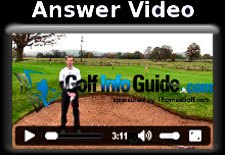You're Correct!

OK, we cheated a little. The question said “easiest,” and we settled on a three-way tie.
Heres the thing: Theres no one easiest way to hit longer drives that applies to every golfer. But there are several simple moves you can make that, depending on whats costing you yards, may produce the extra power you crave. In fact, none of them requires making a single swing change.
Read on for three tips to boost your driving distance.
Modern drivers have enormous heads, so if youre playing a newer model, your first task is to buy a bag of extra-long tees. Practice on the range by varying your teeing height, noting which height delivers the highest flight with consistently solid contact. Go too high and youll flatten your swing, which can actually lower the balls trajectory.
There you have it – the easiest ways to hit longer drives. Of course, there are other, more complicated ways to boost your distance. Click through the links below for additional tips.
Create More Power with Full Shoulder Turn
Leverage Your Power with Downswing Squat
Widen Stance to Add Power, Accuracy
Women: Thumbs Up to Groove Powerful Release
Seniors: Stop Backswing Sway for More Power
Sorry Try Again! - See Explanation Below
Golfers with swing speeds below 100 mph – the vast majority of us – generally shouldnt play a driver with less than 10° of loft. The goal is to launch the ball high with enough spin to keep it airborne for as long as possible, and it takes lots of clubhead speed to do that with a lower-lofted club.
These days, clubfitting pros often advise amateurs to go with 12° loft or more on their drivers. The added degrees not only generate higher tee shots, they make the driver easier to hit – thus inspiring confidence and aiding better contact.
Along the same lines, you may also be stuck with a shaft thats too stiff. A more flexible model will have much the same effect as a clubhead with more loft.
Sorry Try Again! - See Explanation Below
When hitting a driver, right-handed golfers should set up with the ball opposite their left heel. The farther back (toward center stance) you go, the more you de-loft the clubface and promote a descending blow – good for iron shots, distance-killing on drives.
Ideally, you want to catch the ball with the driver moving ever-so-slightly upward at impact, though a level or mildly descending approach is OK. Setting up with the ball at the front of your stance positions you to do just that.
Watch this video for a tip on checking your ball position, and fixing it if needed: Proper Ball Position Can Cure Swing Ills
Sorry Try Again! - See Explanation Below
This one is even simpler than achieving the correct ball position. If you tee the ball too low, youll catch it low on the clubface and fail to maximize the drivers loft. Tests show that the optimal contact spot for high, long drives is just above the clubs equator. Thus, at least half the ball should be above the drivers top line when teed up.







